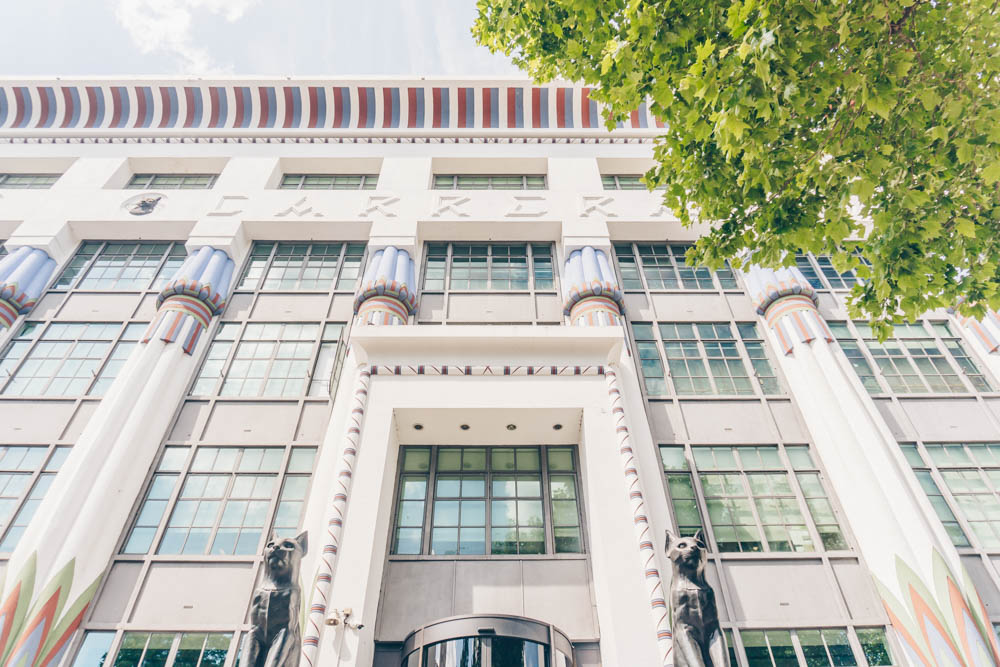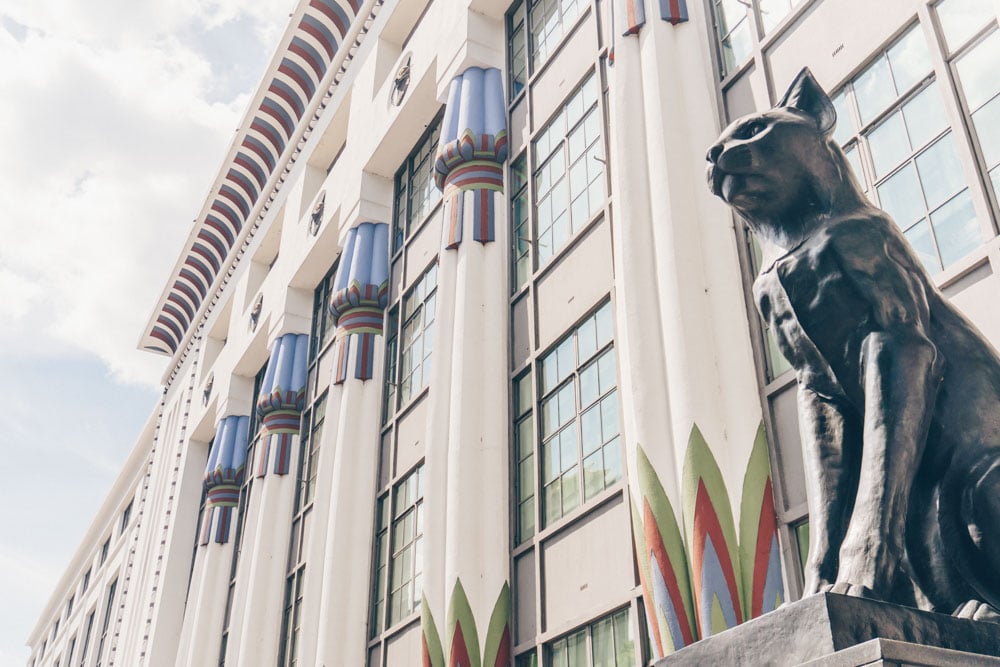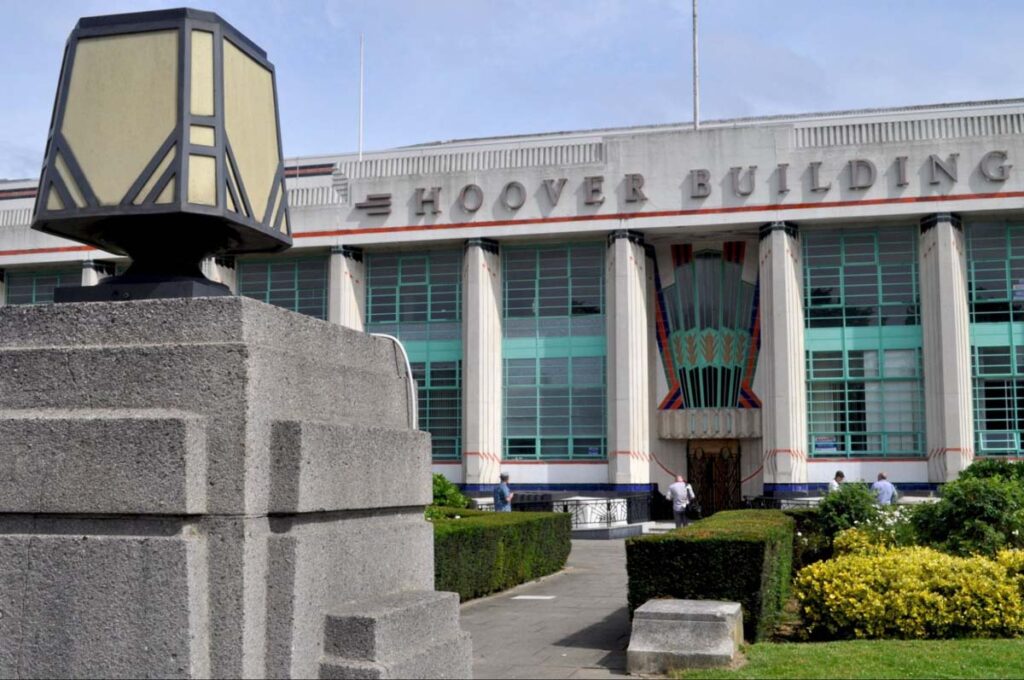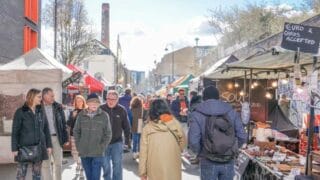
Looking to explore Art Deco architecture in London?
When people think of famous Art Deco buildings, the Chrysler Building in NYC is one of the first that springs to mind. But who needs the Big Apple when you’ve got the Big Smoke?
London isn’t often considered for its Art Deco scene, however, the capital has an arsenal of quirky buildings to explore. These are the ones you shouldn’t miss.
Stunning Art Deco Architecture in London
Carrera’s Cigarette Factory

Possibly one of London’s most curious buildings, Carrera’s Cigarette Factory in Mornington Crescent is an example of where Egyptian Revival architecture meets Art Deco.
After the discovery of King Tut’s tomb in 1922, plenty of Egyptian-style buildings popped up on London’s streets – and when designing the Carrera Factory, Marcus Evelyn and O.H Collins decided to go all out.
Onyx cats and tall pillars adorn the front of the building – though, many of these are restored replicas after the building was stripped of its character in the 60s. Still, there’s no better place in the capital to catch a glimpse of architecture from years gone by.
Freemasons’ Hall
Freemasons’ Hall is a perfect example of classic Art Deco architecture, and has been a meeting place for Freemason’s in the UK since 1775.
The building is also the HQ for the United Grand Lodge of England and the Supreme Grand Chapter of Royal Arch Masons of England (try fitting that on a t-shirt!).
The current Grade II listed building – which is actually the third to stand on this site – was designed by Henry Victor Ashley and F. Winton Newman and opened in 1933 as a tribute to the 3,225 Freemasons who were killed during WWI.
Without a doubt, the Grand Temple is the most interesting part of this building – the huge cove is decorated with mosaics depicting Masonic symbols and rituals.
Keen to explore? The hall welcomes the public from Monday to Saturday, so you can have a nose around inside. Expect to be greeted by grand geometric flooring and gold accents adorning the walls.
Arnos Grove
We admit, Arnos Grove is a rather controversial one.
Whereas other Art Deco buildings in London are pretty easy on the eye, it has to be said that this one is a little bit ugly – perhaps it was the precursor to some of London’s Brutalist Architecture when it was built in the early 1930s?
Architect Charles Holden was responsible for this interesting work, and the Grade II listed station remains in use today.
Built using brick, glass, and reinforced concrete, the circular design was rumoured to have been inspired by the Stockholm City Library.
Though Holden’s assistant was quick to dispel this, instead claiming that the tube station was in fact influenced by the Groundsman’s Lodge at Midhurst Sanatorium, that Holden had previously worked on.
Phoenix Theatre
When Phoenix Theatre first opened its doors in 1930, debuting with Noel Coward’s Private Lives, it was one of the best examples of modern architecture in London – and today it still encapsulates Art Deco perfectly.
Three arched windows (and three arched doors) are decorated with the architectural style’s typical sunburst motifs. While the bright neon sign brings a touch of Moulin Rouge to the capital.
The inside of the theatre is just as interesting as its exterior. To catch a glimpse of its opulence – and the Italian-influenced auditorium – you need to watch a show.
Unilever House
Blending traditional Art Deco with the more Gothic Neoclassical style, it’s clear that Unilever House is a striking building.
The exterior curves along Victoria Embankment, and the added texture on the bottom level – and the absence of windows – was purposefully thought through to reduce inside noise from traffic outside.
James Lomax-Simpson was obviously feeling a little bit wild when designing this building in 1933 – not only did he add giant columns that stretch between the fourth and sixth floor, but he claimed sole ownership of the design, which is something that many people dispute.
St Olaf House
Built between 1928 and 1932 on the previous site of St Olave’s Church, the Grade II listed St Olaf House is a part of London Bridge Hospital.
The six-story building is made from Portland stone and is covered in 39 terracotta panels, courtesy of Frank Dobson. Dobson also designed the black and gold mosaic of Olaf II of Norway on the building, who helped protect London from Danish invaders in 1014.
Hoover Building

One of the coolest examples of Art Deco buildings London boasts is the Hoover Building, not to mention the fact it’s home to the quirkiest Tesco in the country.
Designed by Wallis, Gilbert and Partners, the site first opened in Perivale, Ealing in 1933 as the UK HQ of The Hoover Company – though the property is now owned by IDM and has been transformed into a range of ultra-cool Art Deco flats.
The original entrance to the main building features a colourful geometric door and a grand staircase that wouldn’t be out of place in Jay Gatsby’s house.
Plenty of people criticise the building, claiming the style is all over the place and incohesive, but you’ll have to head on over to snap a few photos of the fascinating building and see for yourself. We’re big fans.
Shell Mex House
It’s impossible to miss Shell Mex House – a.k.a 80 Strand – and its iconic Art Deco architecture. Located on the former spot of Cecil Hotel, it’s giant clock face gives Big Ben a run for its money.
The 12-floor building was originally built with the purpose of being the HQ of Shell-Mex and BP (a joint company that was launched in 1932), though today the Art Deco building is home to a plethora of businesses, including a gym that looks over the Thames.
Daimler Garage
Whilst the Daimler Car Garage has closed for good, the imposing building still remains for visitors to marvel at.
This is another creation by Wallis, Gilbert and Partners, who were responsible for a hefty chunk of Art Deco buildings in the capital.
The frontage is sleek and uniform – rectangular windows are pimped up by emerald tiles and the round portion of the building really encapsulates the main characteristics of the style.
Practical Tips for Visiting London’s Art Deco Buildings
Between the two World Wars, Art Deco buildings catapulted in popularity.
This quirky style originated in Paris in the early 1900s, and when Auguste Perret and Henri Sauvage designed apartment buildings on rue Benjamin Franklin and rue Trétaigne respectively, this distinctive – and at the time, modern – style was born.
The likes of Eliel Saarinen and Albert Aalbers soon pioneered this new style around the world. From Indonesia to America, the world was going gaga for Art Deco and buildings made from reinforced concrete and covered in garish embellishments were everywhere.


